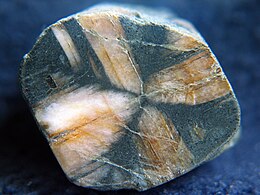
Summary
Chiastolite (/kaɪˈæstəˌlaɪt/ ky-ASS-tə-lyte)[1] is a variety of the mineral andalusite with the chemical composition Al2SiO5. It is noted for distinctive cross-shaped black inclusions of graphite. The presence of the cross caused this mineral be used as a gem. Chiastolite specimens were distributed throughout Europe from the 16th century, as an amulet or souvenir provided by the pilgrims returning from Santiago de Compostela (Saint James of Compostella), in Spain. In the old books of mineralogy, chiastolite appears it is cited with the name of lapis crucifer or lapis cruciatur, cross stone. The first figure of a chiastolite appears in Laet's book De Gemmis et Lapidibus, published in 1648.[2] The chiastolite specimens sold to the pilgrims came from Asturias, where it is very abundant, in large specimens, in the area of Boal.[3]

In areas around Georgetown, California, US, metamorphosed sediments contained andalusite and chiastolite in a graphite-rich metasediment. The chiastolite crystals have been pseudomorphically altered by a mixture of muscovite, paragonite and margarite. The calcium-rich margarite tends to form along the graphite-rich crosses or bands within the chiastolite. Mineralogically the occurrence is important because all three white mica phases are present in an equilibrium assemblage.[4]
There are several theories regarding the formation of the chiastolite cross, however the most widely accepted theory, proposed by Frondel in 1934, suggests that there is a selective attachment of impurities at the rapidly growing corners of andalusite crystals. As the concentration of these impurities (which consist primarily of graphite) increases, the growth of the crystal is slowed. This concentrated impurity deposit forms a re-entrant as it is absorbed by the growth of the andalusite porphyroblast. The cycle of growth-retardation-growth then repeats itself, creating a featherlike pattern of graphite along four radiating "arms".[5]
References edit
- ^ "chiastolite". Dictionary.com Unabridged (Online). n.d.
- ^ Calvo, Miguel (2016). "El "lapis crucifer", "piedra de cruz de Compostela": un elemento importante de los patrimonios geológico y cultural del NW de España" (PDF). De Re Metallica (in Spanish). 26: 67–79.
- ^ Calvo, Miguel (2018). "Silicatos". Minerales y Minas de España (in Spanish). Vol. IX. Madrid: Escuela Técnica Superior de Ingenieros de Minas de Madrid. Fundación Gómez Pardo. pp. 98–101. ISBN 978-84-8321-883-9.
- ^ Guidotti, C. V.; Post, J. L.; Cheney, J. T. (1979). "Margarite pseudomorphs after chiastolite in the Georgetown area, California" (PDF). American Mineralogist. 64: 728–32.
- ^ Winter, J. D. (2009). Principles of Igneous and Metamorphic Petrology (2nd ed.). Prentice Hall. p. 506. ISBN 978-0321592576.
External links edit
- . New International Encyclopedia. 1905.


